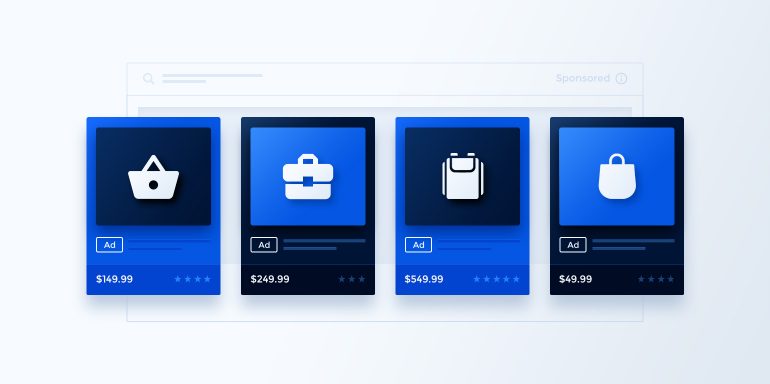An online merchant’s success hinges on their ability to attract new customers to their digital storefront. To do that, one of the leading traffic sources are Product Listing Ads.
Advertising with PLAs has become increasingly popular since their launch in 2010. These ads give merchants the opportunity to highlight their products when users search for them, and the chance to immediately outshine competing brands who only use expanded text ads.
What are Product Listing ads?
Product Listing ads (aka Shopping Ads or Google Shopping Ads) are used by ecommerce brands on desktop and mobile to promote online and local inventory, boost website traffic, and generate qualified leads. PLAs are displayed in search results in Google and Bing featuring a product image, title, price, store name, and link:
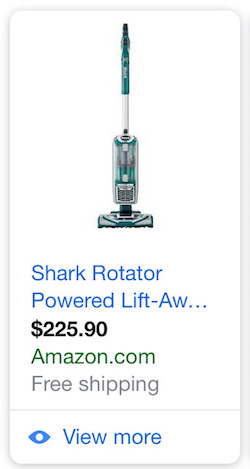
Unlike other Google ads, PLAs are tailored toward products and product categories, rather than keywords. They also appear above text ads and search results:
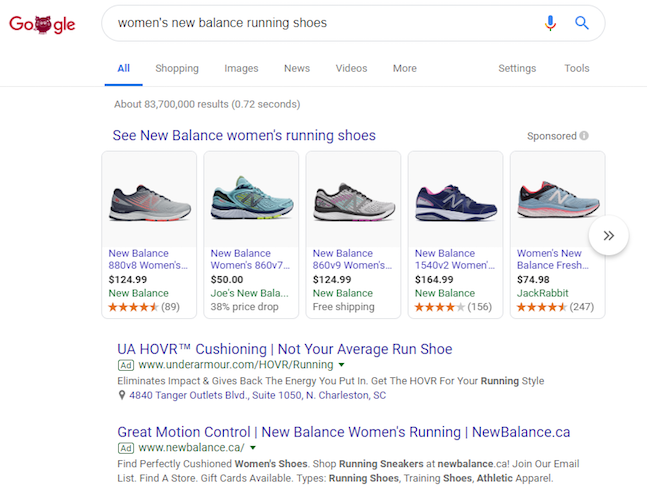
To the right of text ads and search results (except mobile):
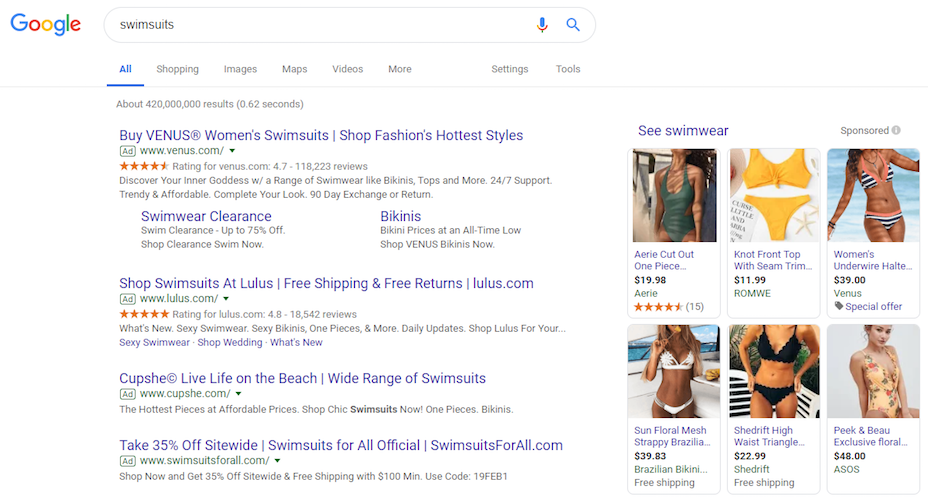
In the “Shopping” tab:
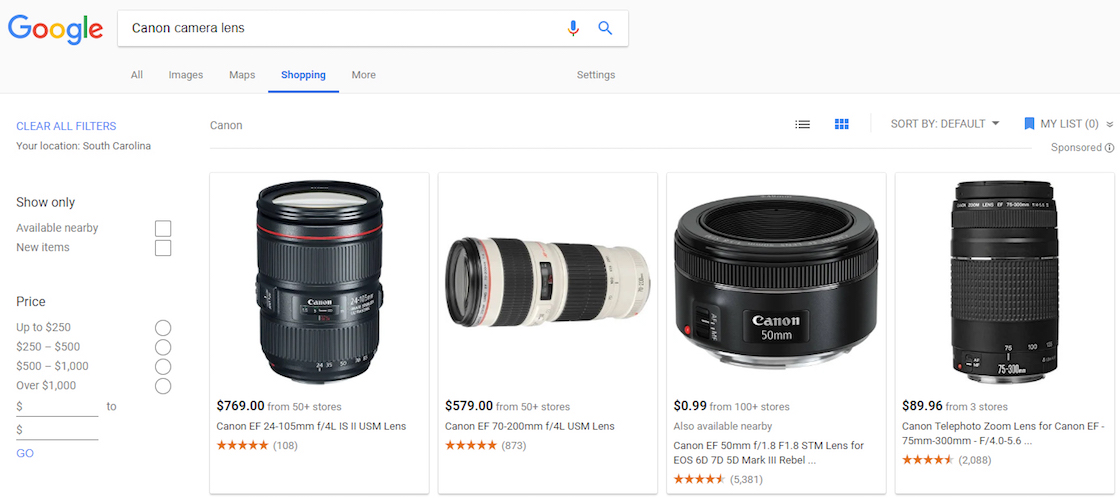
And in the “Images” tab:
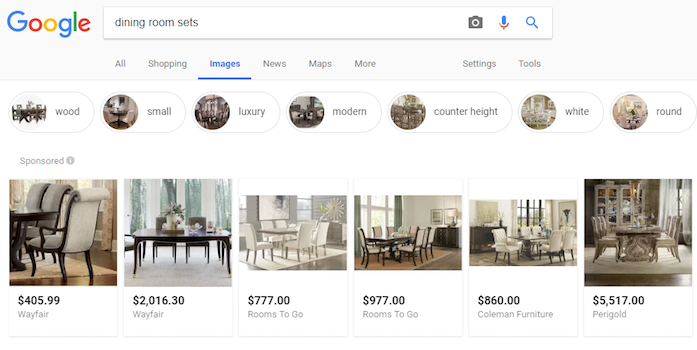
You can also find them on Google Search Partner websites (including YouTube), and the Google Display Network (local catalog ads only).
Why use Google Product Listing ads?
Google Shopping dominates other shopping channels. In Q1 of 2017, Google Shopping accounted for 52% of click share for retailers. This marked the first time PLA clicks exceeded text ad clicks. For non-branded search terms, Google PLA click share was even higher, at an impressive 75%.
Several reasons make Product ads unique over other ad types:
More traffic
Even when shown right next to each other for shopping-related searches, many businesses experience significantly higher CTR with PLA ads compared to text ads. Some advertisers have even experienced double or triple standard CTR.
Better qualified leads
Featuring product information directly in your ads helps shoppers make informed purchase decisions, increasing the lead quality and the likelihood they’ll purchase.
For example, if someone searches for “laptops,” they might be able to tell which laptop fits their style just by looking at the PLA images. They can also quickly see which ones fit their budget by viewing the price. So by the time the shopper clicks the ad, they already have a good sense of the product and its cost, which positions them further down the sales funnel.
Retail-centric campaign management
Instead of keywords, Google Product Listing ads use product attributes defined in your Merchant Center data feed to show ads with relevant searches. This allows you to browse your product inventory directly in Google Ads, and create product groups for items you want to bid on.
Increased visibility
Google allows more than one of your PLAs to appear for a given search. Also, a Product Listing ad and a text ad can appear at the same time. Your reach for a single search could double.
Powerful reporting
With PLA campaigns, you can see how your ads perform at any level of granularity. For example, if you sell athletic shoes, you can see how many clicks a particular brand of sneakers received just by filtering your products view (no need for new product groups).
Despite all these benefits, there are several factors you should consider before running a Google PLA campaign.
7 Prerequisites of Product Listing ads
PLAs are not suitable for every merchant. Here are some questions to consider:
1. Can you link your Google Merchant Center with your Google Ads account?
This is the main reason PLA campaigns don’t go live. To generate Product ads, Google Ads uses the data feed information you provide to the Google Merchant Center — so if the two accounts aren’t linked, your campaign can’t run.
2. How many products do you sell?
If you sell under 500 products, you may get less visibility than brands with over 500 products.
3. What is your product category?
Less competitive product categories like automotive parts, baby supplies, tools, or furniture are great to promote with PLAs. Conversely, more competitive products, such as apparel or footwear — and you’re not a household brand like Nike or Adidas — you may struggle to profit from this type of campaign.
4. How much can you spend on Google?
Bids and daily budget vary significantly for every merchant. However, to profit with Google PLAs — and ensure your ads display throughout the day — be prepared with the budget to do so.
5. How much do you need to sell to profit with Google Product Listing ads?
If you have extremely strict margins, you may have difficulty profiting, or may need to lower your daily budget. Of course, this varies widely based on your products, competition, and margins.
6. What is the quality of your site?
Google strongly emphasizes site quality and links as part of its algorithm to determine the site and merchant quality.
7. Can you easily make changes to your data feed?
If not, you will be severely limited when managing your PLA campaign. Some technical things you won’t be able to do without making changes to your data feed include (but not limited to):
- Setting up your campaign
- Creating ad groups for best sellers, products over or under a certain price, seasonal items, etc.
- Updating or changing sales for your campaign
- Troubleshooting validation errors (when setting up ad groups)
- Preventing your campaign from getting rejected due to missing or incorrect data feed elements
Once you’ve considered each of the above and decided that you can benefit from PLAs, you must know how to optimize them.
5 Google Product Listing ads best practices
1. Segment product groups
The default setting is “All products.” However, just like you wouldn’t use the same bid on all of your keywords, you don’t want to use identical bids on all of your products. So, create different product groups, using a tiered, relational structure:
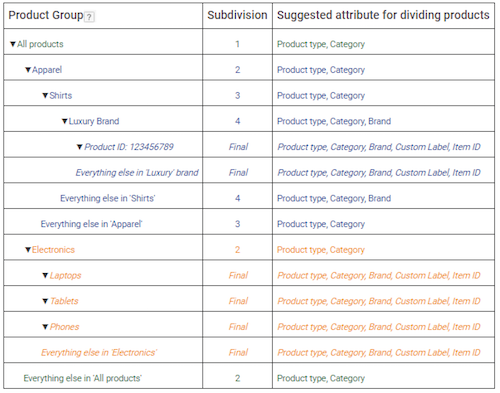
Start with broader divisions, using attributes such as product type and category. Then, if there is enough data and a need for more divisions, continue segmenting products further, with the same or more focused attributes.
This approach will:
- Provide complete bid coverage by capturing your entire inventory
- Give your bidding system more data to inform bid optimization
- Create better visibility into performance reporting
- Align bid management and your objectives
- Simplify account management
- Prevent wasted ad spend on item IDs or small product groups that have little to no activity
2. Create brand and non-brand campaigns
Creating separate branded and non-branded campaigns helps maximize your traffic when users conduct branded product searches. The process is simple:
- Create two shopping campaigns
- Add your brand terms as negative keywords to the non-brand campaign
- Set the brand campaign priority to “low” (a unique shopping campaign setting)
This helps you budget and bid appropriately for brand and non-brand searches, which in most cases, deserve their own bids.
3. Optimize your data feed
Although the full list is longer than this one, here are three quick tips to achieve this:
- Include your brand in the product title to take advantage of your brand’s power
- Use the most specific Google Product Category possible to increase match rates and CTRs
- Use Custom Labels to further categorize your products based on marketing goals, such as ROI or price range
4. Regularly review the Merchant Center
This is important, because the MC will report on any warnings, errors, or violations that your feed may incur, so you can immediately correct them. The majority are easy to fix, and simply require awareness to catch them. Regularly reviewing the MC and correcting any issues ensures all of your products remain active and your data quality score with Google remain high.
5. Add enhancements to your ads
Enhancements may be added to your PLAs to attract more attention. Options include:
- Special offers to feature your online promotions with your ad. There is no additional cost for these, but CPC pricing still applies.
- Product ratings to provide critical information to shoppers making purchase decisions. These only show on ads with a 5-star rating system and a total review count. A product must also have at least 3 reviews to be eligible.
- Google Customer Reviews to collect valuable feedback from customers who’ve purchased from your site.
(Note: When you opt into one of these enhancements, it won’t necessarily display every time your ad shows.)
Ad specs and requirements
In addition to the ad specs below, Google encourages advertisers to ensure everything they submit is the same quality they’d show to a customer.
ID
- Required: Product’s unique identifier
- Syntax: Max 50 characters
- Schema.org property: Product.sku
- Use a unique value for each product (use the product’s SKU where possible)
- Keep the ID the same when updating your data
- Use only valid unicode characters (avoid invalid characters like control, function, or private area characters)
- Use the same ID for the same product, across countries or languages
Title
- Required: Product name
- Syntax: Max 150 characters
- Schema.org property: Product.name
- Match the title from your post-click landing page that accurately describe the product
- Don’t include promotional text like “free shipping,” all capital letters, or gimmicky foreign characters
- For variants, include a distinguishing feature such as color or size
- For mobile devices, include “with contract” if sold with a contractor
Description
- Required: Product’s description
- Syntax: Max 5,000 characters
- Schema.org property: Product.description
- Match the title from your post-click landing page that accurately describe the product
- Don’t include promotional text like “free shipping,” all capital letters, or gimmicky foreign characters
- Only include information about the product (don’t include links to your store, sales information, details about competitors, other products, or accessories)
- Use formatting such as line breaks, lists, or italics
Link
- Required: Your product post-click landing page
- Schema.org property: Offer. url
- Use your verified domain name, and start with http or https
- Use an encoded URL that complies with RFC 2396 or RFC 1738
- Don’t link to an interstitial page unless legally required
- Use an in-domain tracking URL if needed (too many redirects can increase latency)
Image
- Required: Your product’s main image
- Accepted formats: Non-animated GIF (.gif), JPEG (.jpg/.jpeg), PNG (.png), BMP (.bmp), and TIFF (.tif/.tiff)
- Non-apparel products: At least 100 x 100 pixels
- Apparel products: At least 250 x 250 pixels
- Size: 64 megapixels max (or 16MB max file size)
- Do not scale up an image or submit a thumbnail
- Promotional text, watermarks, and borders not allowed
- No placeholders or a generic images, unless:
- Hardware or Vehicles & Parts categories (illustrations accepted)
- Paint category (single color images accepted)
Image link
- Required: The URL of your product’s main image
- Schema.org property: Product.image
- Link to the main image of your product
- Start with http or https
- Use an encoded URL that complies with RFC 2396 or RFC 1738
- Ensure the URL can be crawled by Google (robots.txt configuration allowing Googlebot and Googlebot-image)
Additional image link
- Optional: The URL of an additional image for your product
- Syntax: Max 2,000 characters
- Meet regular image link requirements, except:
- The image can include product staging and show the product in use
- Graphics or illustrations can be included
- Submit up to 10 additional product images by including this attribute multiple times
Mobile link
- Optional: Your product’s mobile post-click landing page URL if different from desktop
- Syntax: Max 2,000 alphanumeric characters
- Meet regular link requirements
For step-by-step instructions on how to set up Google Product Listing ads, visit Google’s support page for shopping campaigns.
Bonus: One major advantage of PLAs not yet mentioned is that you can easily import your Google Product Listing ads to Bing with the Google Merchant Center Import tool.
Don’t forget about Bing Product Listing ads
Bing PLAs use Google data feeds for Catalog feed files, so merchants don’t have to redo the work already completed. All Google-specified attributes are accepted by Bing. However, not all of Google’s fields are used by Bing.
Bing PLA placement is similar to Google’s — above text ads and search results:
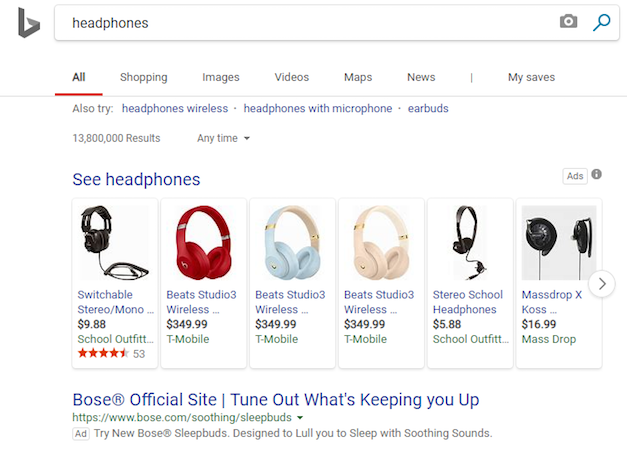
To the right of text ads and search results (except mobile):
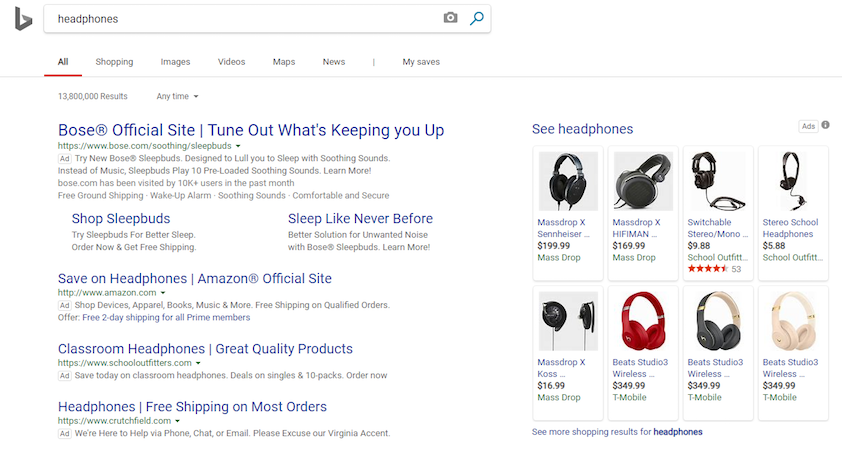
In the “Shopping” tab:
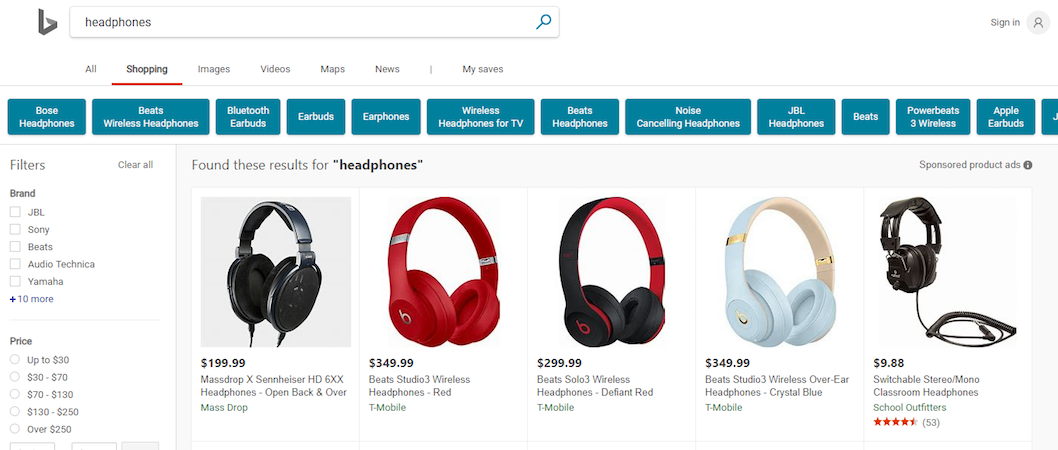
And in the “Images” tab:
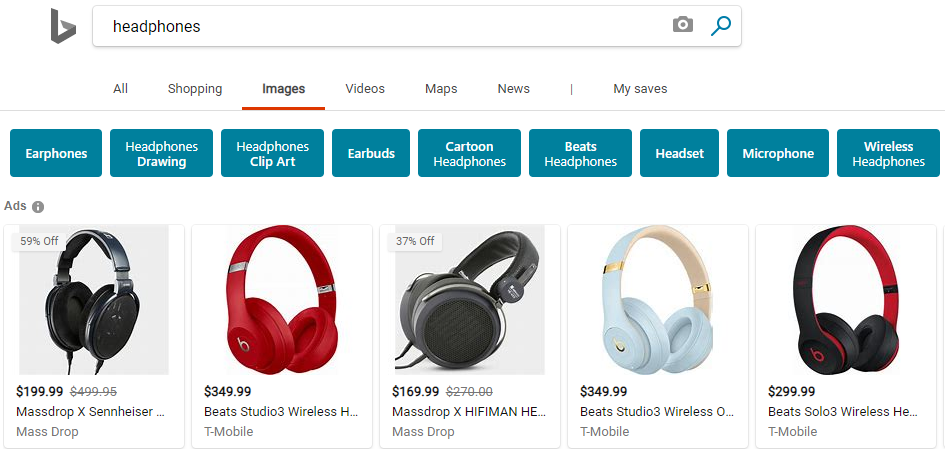
The two search engines share ad specs and requirements for Product Listing ads.
Highlight your products with PLAs
It’s just as important for a retailer to present themselves where someone is shopping, as it is for a shopper to be present in a retailer’s store. Product Listing ads are great for this as they build a strong online presence and seize the prime opportunity to win customers during their product search.
Consider the prerequisites and best practices above to get in front of more shoppers. To get the most from all your ads — the most up to date ad specs, best practices, and ad examples across all platforms — download the Instapage digital advertising reference guide today.
